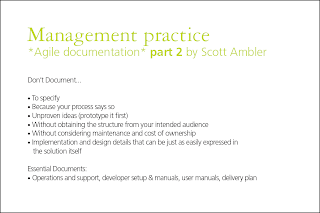The first card I thought would be interesting to look at is a Management Practice titled "Agile Documentation". Documentation is often overemphasized by some project teams or ignored by others depending on whether they subscribe to a waterfall or iterative based process. There is no clear cut answer on exactly "how much" documentation should be done as it is dependent on a variety of scaling factors.
Regardless of which development process your team may subscribe to, if we go back to the "why" behind documentation, I think applying Agile Documentation will help any team minimize documentation waste while also providing the benefits of documentation (yes, documentation is a good thing and even agile teams need to document as going agile is not an excuse to avoid documentation).
The LEAN Agile Documentation card states:
Document...

- When the business asks you to
- For clarity across teams working in different locations
- To establish appropriate business and technical context for the solution
- To define interfaces across systems
- To enable your next effort
- Informally
- To understand
- To communicate
Don't Document...
- To specify
- Because your process says so

- Unproven ideas (prototype it first)
- Without obtaining the structure from your intended audience
- Without considering maintenance and cost of ownership
- Implementation and design details that can be just as easily expressed in the solution itself
There are three main themes I want to pull out from this card that I think are worthwhile to discuss.
1) Document for an audience - Documentation requires time and effort and the business is paying for this just like they are paying for each feature built into the solution. Every project should contain estimates for time/effort (i.e. cost) towards documentation and this is something the business is paying for. If you look at many organizations and their development processes you will notice that there is often a large set of documentation that needs to be completed as part of the project. However, it's worth questioning does the business really need each one of these documents? Does the technology teams building and supporting the solution need these documents? If the team is documenting...
- Because your process says so
- Without obtaining the structure from your intended audience
Then it's likely the team is not documenting for the business. Generally the type of documentation I find invaluable to the business and the technology teams supporting the solution are operations and support manuals (e.g. run books), developer setup and build manuals, end user manuals and the delivery or release plan. This set may need to be expanded depending on the project.
2) Avoid documenting things that will change - Just like code and test cases, documentation is impacted by changes. To avoid paying the "rework" cost, hold off on documenting until a steady state is achieved (document at the last responsible moment) and stay away from implementation and detailed design details that will require frequent changes to the documentation.
3) Document to understand, communicate and establish contracts - It's important to recognize when the scaling factors impact your project and documentation is a great way to mitigate these risks and challenges. When your team is:
- Geographically distributed
- Large and difficult to manage
- Working in a complex business domain
Then documentation helps everyone understand the same language, communicate decisions and changes, and establishes contracts that helps each member understand how their work interacts with everyone else. The type of documentation I find myself often using to help the team navigate through these challenges are the high-level requirements (e.g. use case hierarchy) produced from the initial requirements envisioning sessions, ubiquitous language dictionary and high-level domain model, system context diagrams and bounded contexts, and system interfaces. An extremely effective practice that I often apply to documenting system interfaces or complex business domains is to use "executable requirements". Writing test cases as a form of documentation is a great way to precisely capture the details while also validating for correctness.
I have found these three themes combined with the bullet point checklists in the Agile Documentation practice card to be incredibly helpful in deciding what and when to document.
No comments:
Post a Comment